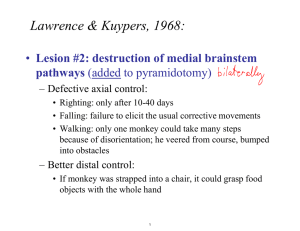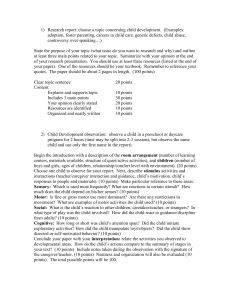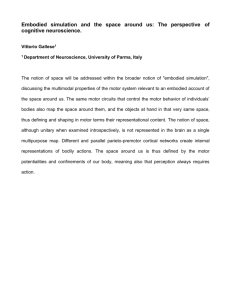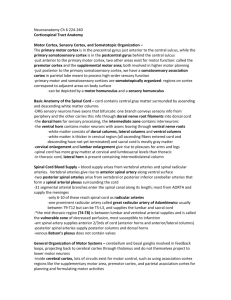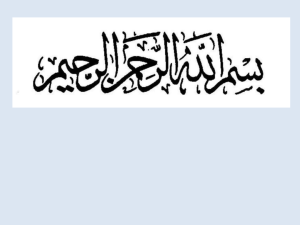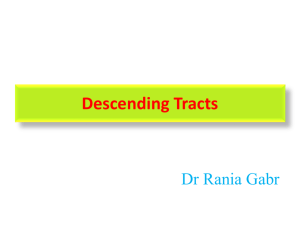Organization of the Motor System Outline
advertisement
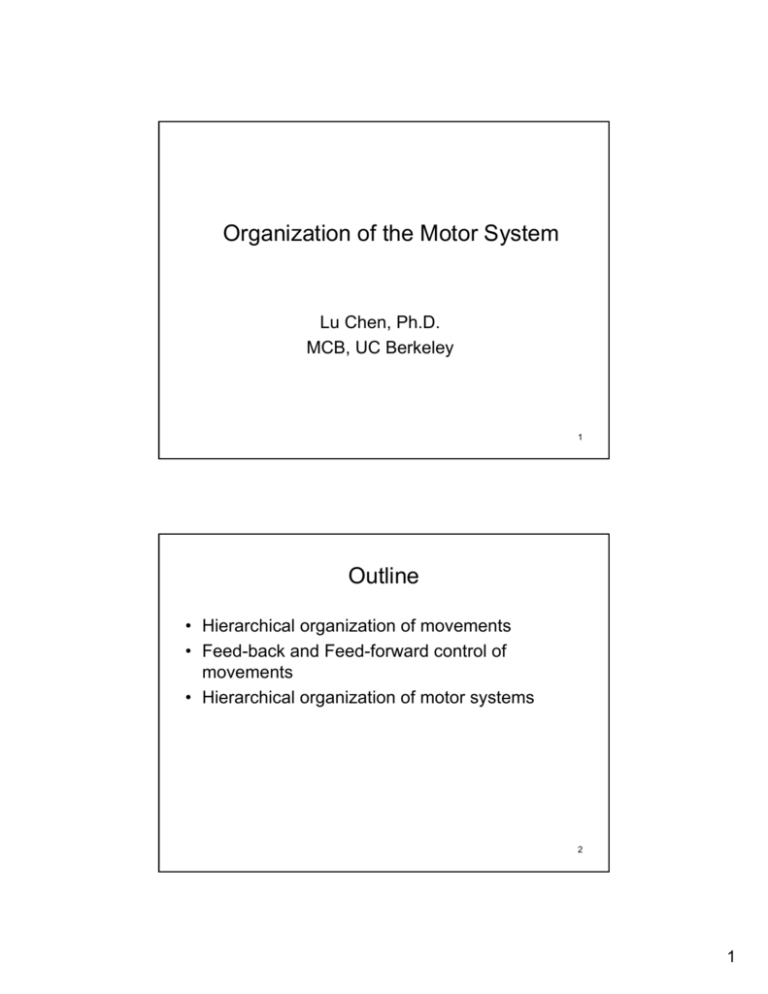
Organization of the Motor System Lu Chen, Ph.D. MCB, UC Berkeley 1 Outline • Hierarchical organization of movements • Feed-back and Feed-forward control of movements • Hierarchical organization of motor systems 2 1 The Motor Systems Generate movements that are hierarchically organized • Rapid (reflexive) response to harmful stimuli • Maintain posture with respect to gravity • Voluntary, purposeful movements 3 Overview - organization of motor systems voluntary movement posture & balance reflex coordination Motor Cortex Brain Stem Spinal Cord Motor neuron pools Skeletal muscle 4 2 Reflex • Involuntary movement, mediated by motor circuitry in the spinal cord • Coordinated patterns of muscle contraction and relaxation • Movement governed by the type of sensory receptors stimulated – Stretch receptors produce stretch reflexes – Cutaneous receptors produce withdrawal reflex 5 Voluntary Movement • Initiated to accomplish a specific goal • Triggered by external stimuli • Improve with practice 6 3 Voluntary Movement • Responds to feedback mechanisms to correct for internal and external changes • Two types of feedback mechanisms • Feed forward • Feed back 7 Feed-back Control • Reactive – Responds to the current state of affairs • Depends on sensory signals – To detect changes and perturbations in the state of affairs • Characterized by gain – Gain is kept relatively low so as to be sensitive to changes in the state of affairs 8 4 Feedback control: command specifies desired state Desired state Error signal Reference signal (~ command) Controller (ie, filtering, amplification Actuator (eg, muscle) + comparator - Feedback signal Input processing (ie, filtering, amplification) Sensor (eg, muscle spindle) 9 Feed-forward Control • • • • Anticipatory Depends on experience, senses Essential for rapid action Can modify the operation of feedback mechanisms 10 5 Feed-forward control: command specifies response Feed-forward controller (with memory) Input processing (ie, filtering, amplification) Sensor detects distant events (eg, eyes) Anticipatory command Controller (ie, filtering, amplification Input processing Actuator (eg, muscle) Sensor Feedback signal 11 Catching a ball requires feed-forward and feedback controls The anticipatory responses, before the impact of the ball, consist of coactivation of biceps and triceps muscles. After impact there is a transient activation of the stretch reflex with further co-activation of flexor and extensors. 12 6 Feedforward and feedback mechanisms of postural control 13 Hierarchical Organization of Motor Systems • Level 1: The spinal cord • Level 2: The brain stem • Level 3: The cortex 14 7 A Little Brain Anatomy… Forebrain Brainstem Cerebellum Spinal cord 15 Hierarchical Organization of Motor Systems Level 1: The spinal cord • Mediates reflexes, automatic movement • Motor neurons and interneurons in spinal cord receive projections from higher centers that modulate these movements 16 8 Hierarchical Organization of Motor Systems Level 2: The Brain Stem Two Systems: • Medial Descending Systems – Integrate visual, vestibular, somatic information – For control of posture • Lateral Descending System – Controls distal muscles (e.g., arm & hand) 17 The Medial Descending Systems Superior colliculus (Receive visual information) Tectospinal tract Vestibular nuclei Vestibulospinal tract Reticular formation Reticulospinal tract Controls the head balanced on the shoulders as the body moves through space Controls the antigravity reflexes 18 9 The Lateral Descending Systems - from brain stem nucleus The Red nucleus Rubrospinal tract Rubrospinal tract controls goal-directed limb movements such as reaching and manipulating. 19 Hierarchical Organization of Motor Systems Level 3: The Cortex • Motor Cortex (primary motor cortex, premotor and supplementary motor cortex) • Projects directly – to the spinal cord to regulate movement – Via the Corticospinal Tract • Projects indirectly – Via the Brain stem to regulate movement 20 10 The Motor Cortex Primary motor cortex Supplementary motor cortex Premotor area 6 anterior 4 posterior 21 The Lateral Descending Systems - from cortex Corticospinal tract 22 11 Effects of the lateral pathway lesions • Late 1960s, done by Lawrence and Kuypers. • Lesions in both corticospinal and rubrospinal tracts in monkeys. • Unable to make fractionated movements of the arms and hands. Unable to move shoulders, elbows, wrists and fingers independently. • Voluntary movements were slower and less accurate. • Able to maintain normal posture. 23 Babinski reflex and corticospinal tract lesion 24 12






